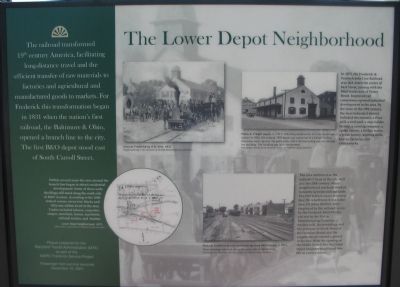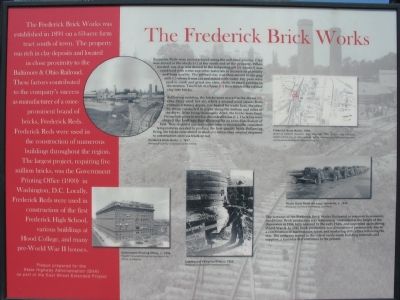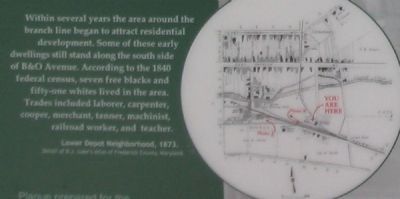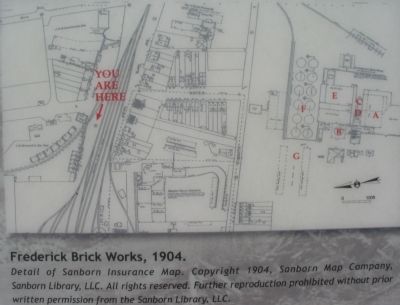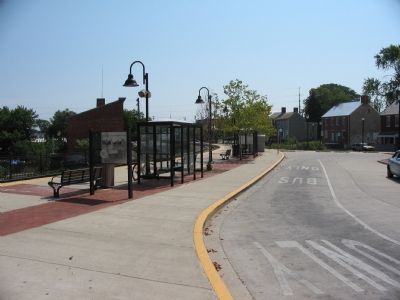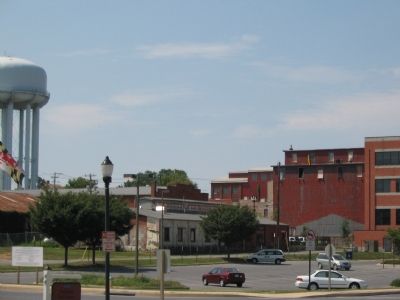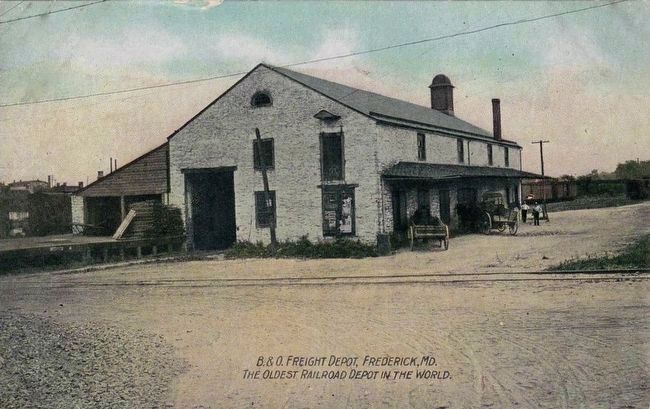Frederick in Frederick County, Maryland — The American Northeast (Mid-Atlantic)
The Lower Depot Neighborhood / The Frederick Brick Works
The railroad transformed 19th century America, facilitating long-distance travel and the efficient transfer of raw materials to factories and agricultural and manufactured goods to markets. For Frederick this transformation began in 1831 when the nation's first railroad, the Baltimore & Ohio, opened a branch line to the city. The first B&O depot stood east of South Carroll Street.
(Upper Right Sidebar): In 1872, the Frederick & Pennsylvania Line Railroad was laid down the center of East Street, joining with the B&O tracks east of Water Street. Improved rail connections spurred industrial development in the area. By the close of the 19th century, the local industrial district included two tanners, a flour mill, a coal yard, a step-ladder factory, a canning company, a spoke factory, a bridge works, a brush factory, knitting mills, two ice factories, and a brickworks
(Lower Right Sidebar): The area continued as the industrial heart of the city well into the 20th century. Many neighborhood residents worked in nearby factories and coal yards. The 1910 federal census indicated that 236 inhabitants lived in the area. Of these, thirteen were employed by the railroad, seven by the Frederick Brick Works, and ten by the Union Manufacturing Company, a hosiery mill. As technology and the economy evolved, many of the factories closed, and the neighborhood entered a period of decline. With the opening of the MARC branch line, the Lower Depot Neighborhood found new life in a new century.
Plaque prepared for the Maryland Transit Administration (MTA) as part of the MARC Frederick Service Project
Passenger train service resumed December 10, 2001
(South Facing Side): The Frederick Brick Works
The Frederick Brick Works was established in 1891 on a 63-acre farm tract south of town. The property was rich in clay deposits and located in close proximity to the Baltimore & Ohio Railroad. These factors contributed to the company's success as manufacturer of a once-prominent brand of bricks, Frederick Reds. Frederick Reds were used in the construction of numerous buildings throughout the region. The largest project, requiring five million bricks, was the Government Printing Office (1900) in Washington, D.C. Locally, Frederick Reds were used in construction of the first Frederick High School, various buildings at Hood College, and many pre-World War II houses.
(Center Sidebar): Frederick Reds were manufactured using the soft-mud process. Clay was stored in the sheds (A) at the south end of the property. When needed, raw clay was moved to the tempering pit (B) where it was combined with water and other materials to increase its plasticity and burn quality. The refined clay was then moved to the pug mill (C) where it was cut and mixed with water. Dry pans were used to crush and grind any slate, shale, or small pebbles in the mixture. Two brick machines (D) then molded the refined clay into bricks.
Following molding, the bricks were moved to the dryers (E). One dryer used hot air, while a second used steam. Both contained tunnel dryers, one heated by waste heat, the other by steam conducted in pipes along the bottom and sides of the dryer. After being thoroughly dried, the bricks were fired. Firing took place in twelve, downdraft kilns (F). The kilns were shaped like beehives, thus allowing for an even distribution of heat. They required constant supervision to maintain the consistent temperatures needed to produce the best quality brick. Following firing, the bricks were stored in sheds (G) where they awaited shipment to construction sites via truck or rail.
(Lower Right Sidebar): The fortunes of the Frederick Brick Works fluctuated in response to economic conditions. Brick production was temporarily suspended at the height of the depression in 1934, fully restored by the early 1940s, and suspended again during World War II. In 1946 brick production was discontinued permanently due to a combination of maintenance, labor, and marketing difficulties following the war. The company turned to the sale of ready-made building materials and supplies, a business that continues to the present.
Plaque prepared for the State Highway Administration (SHA) as part of the East Street Extended Project.
Topics and series. This historical marker is listed in these topic lists: Industry & Commerce • Railroads & Streetcars. In addition, it is included in the Baltimore and Ohio Railroad (B&O) series list. A significant historical date for this entry is December 10, 1938.
Location. 39° 24.699′ N, 77° 24.315′ W. Marker is in Frederick, Maryland, in Frederick County. Marker is at the intersection of B & O Avenue and South East Street, on the right when traveling west on B & O Avenue. Located at the passenger platform for the Frederick Terminal of the MARC. Touch for map. Marker is in this post office area: Frederick MD 21701, United States of America. Touch for directions.
Other nearby markers. At least 8 other markers are within walking distance of this marker. The Frederick County History Bell (about 400 feet away, measured in a direct line); Gen. Bradley T. Johnson (about 400 feet away); The Frederick Brick Works (about 600 feet away); Tanneries (about 600 feet away); The Stinky Stuff (about 700 feet away); Old Freight Depot (about 700 feet away); The Story of Community Bridge (about 800 feet away); Old Hill Church (approx. 0.2 miles away). Touch for a list and map of all markers in Frederick.
More about this marker. Images on the North Side include a drawing of "Atlas at Frederick by H.D. Stitt, 1927." Photo A is of the "Freight Depot, c. 1911. Following construction of a new passenger station in 1854, the original 1832 depot was converted to a freight facility. Doorways were cut into the gable ends, and a railroad was run through the building. The building was later demolished." Photo B is the "Frederick Branch and Dwellings along B&O Avenue, c. 1911. These buildings still exist along the south side of B&O Avenue." A map of "Lower Depot Neighborhood, 1873" carries the caption, "Within several years the area around the branch line began to attract residential development. Some of these early dwellings still stand along the south side of B&O Avenue. According to the 1840 federal census, seven free blacks and fifty-one whites lived in the area. Trades included laborer, carpenter, cooper, merchant, tanner, machinist, railroad worker, and teacher."
The South Side displays a diagram of "Frederick Brick Works, 1904" from a Sanborn Insurance Map. Photographs include "Frederick Brick Works, c. 1897," "Government Printing Office, c. 1936," "Loading and Firing the Kilns, c 1932," and "Trucks Stand Ready for Local Deliveries, c. 1940."
Also see . . .
1. Short History of the Frederick Branch of the B&O Railroad. (Submitted on October 7, 2007, by Craig Swain of Leesburg, Virginia.)
2. The Frederick Brick Works. Still doing business, specializing in masonry and building materials. (Submitted on October 7, 2007, by Craig Swain of Leesburg, Virginia.)
Credits. This page was last revised on December 28, 2020. It was originally submitted on October 7, 2007, by Craig Swain of Leesburg, Virginia. This page has been viewed 3,511 times since then and 58 times this year. Photos: 1, 2, 3, 4, 5, 6. submitted on October 7, 2007, by Craig Swain of Leesburg, Virginia. 7. submitted on November 12, 2015.
